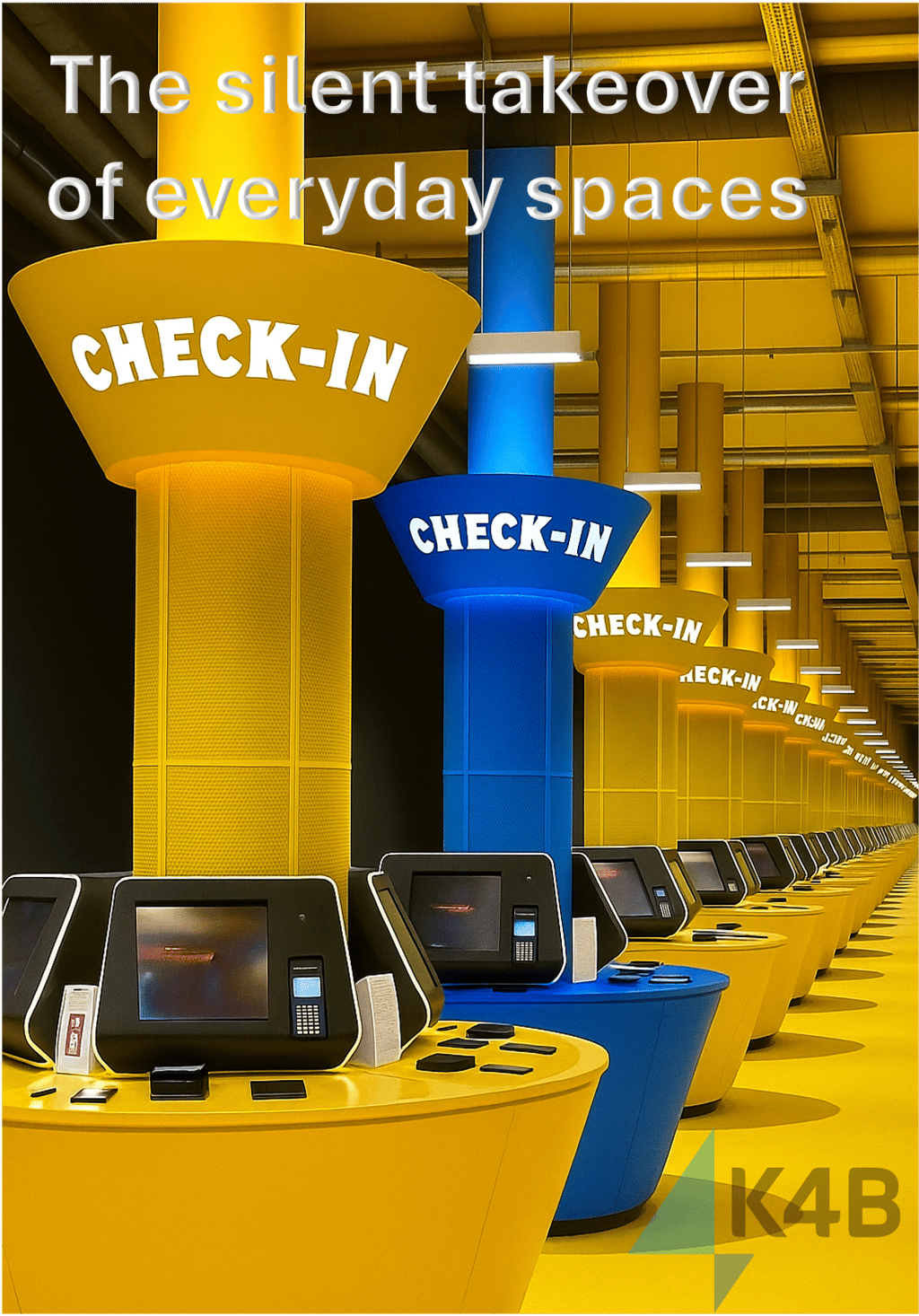The Silent takeover of everyday spaces
An exposé of how, where and why touchscreen kiosks are and will increasingly be found in every part of life


The Silent Takeover of Everyday Spaces
In airports, restaurants, shopping malls, and hospitals, a glowing screen quietly stands by, ready to serve. Touchscreen kiosks have slipped into our daily lives with little fanfare, yet their presence feels almost indispensable. Why?
They are not loud or disruptive, but rather subtle, convenient companions that shape how we order, check in, or find information. Their rise is not accidental—it is the result of cultural shifts, technological leaps, and our collective appetite for speed and autonomy.
From Vending Machines to Digital Hubs - The journey began with mechanical vending machines. Drop in a coin, pull a lever, and out came a product. These early self-service tools were functional but rudimentary. Over time, they evolved into sophisticated digital hubs capable of handling ticketing, payments, and customer support. What was once novelty became utility, and soon, indispensible.
The Birth of the Touchscreen Era - The true revolution came with touchscreens, initiated by mobile phone and tablet introductions. No longer were users restricted to clunky buttons or static menus. With a swipe or a tap, services became fluid, interactive, and almost human-like in their responsiveness. The touchscreen era turned machines from transactional devices into intuitive companions.
User Expectations Have Redefined Convenience - The smartphone generation demanded more. Used to seamless navigation in the palm of their hands, people began to expect the same simplicity everywhere else. Convenience was no longer optional—it was mandatory. This expectation has fueled the widespread adoption of kiosks across industries.
The Appeal of Touchscreen Kiosks for Businesses
Reducing Costs While Improving Efficiency - Kiosks act like tireless employees. They process orders, handle transactions, and guide customers without rest or error. For businesses, this translates into lower labour costs and higher efficiency, especially during peak demand.
Kiosks Turn Every Interaction Into Valuable Data - Each touch on a kiosk tells a story. From popular menu choices to frequently searched products, kiosks gather real-time insights. Businesses can use this data to refine offerings, adjust pricing, and tailor experiences to customer behaviour. The screen doubles as a service tool and a window into consumer patterns.
Kiosks Create a Modern Brand Image - Beyond function, kiosks signal progress. A sleek digital interface conveys innovation and sophistication. For customers, interacting with a kiosk often feels like stepping into a brand that values modernity and efficiency.
The Customer Perspective: People Prefer Them
Faster Service Without the Frustration of Queues - Nobody enjoys waiting in line. Kiosks disperse crowds by offering multiple points of service. Customers get what they need quickly, without the stress of long queues or rushed interactions.
Personalised Experiences at the Tap of a Finger - Customisation is a hallmark of kiosks. Whether adding extra toppings to a meal or selecting a preferred flight seat, users enjoy the freedom to personalise their experience without judgment or pressure.
Accessibility Features That Welcome Everyone - Modern kiosks are designed with inclusivity in mind. Options for larger text, voice guidance, and intuitive layouts make them usable for a wide range of people, including those with disabilities or limited tech familiarity.
Industries that are Leading the Way:
Retail: Reinventing the Shopping Journey - In stores, kiosks act as self-checkout counters, product locators, and digital catalogues. They bridge the gap between online convenience and in-store experiences.
Restaurants: From Ordering to Payment Made Simple - Fast-food chains and coffee shops have embraced kiosks to speed up orders. Customers browse menus, customise meals, and pay—all with minimal human interaction. Accuracy improves, and so does satisfaction.
Healthcare: Streamlined Patient Check-Ins and Information Access - Hospitals use kiosks for appointment scheduling, registration, and information distribution. They help reduce paperwork, save time, and protect patient privacy.
Banking: A Safer, Faster Route to Everyday Transactions - From balance inquiries to cash deposits, kiosks handle a wide range of banking needs. They extend service hours and reduce dependency on tellers.
Travel and Hospitality: Making Navigation and Check-Ins Effortless - Airlines and hotels rely heavily on kiosks for boarding passes, room keys, and check-ins. For travellers, they remove layers of stress by simplifying essential tasks.
Designing Kiosks That Truly Work:
The Importance of User-Friendly Interfaces - kiosks must feel intuitive. Clear layouts, responsive screens, and straightforward navigation reduce friction and encourage adoption.
Creating Form and Function in Public Spaces - Kiosks aren’t just machines—they’re part of the environment. Great design ensures they withstand heavy use while blending into the aesthetics of airports, hotels, or restaurants.
Multilingual and Inclusive Design for Diverse Audiences - In global cities, kiosks must speak many languages. Offering multilingual support and culturally sensitive design ensures no customer feels excluded.
Challenges Behind the Glass Screen
Maintenance and Durability in High-Traffic Environments - Constant use leads to wear and tear. From cracked screens to unresponsive sensors, kiosks require regular upkeep to stay reliable.
Cybersecurity and Protecting Customer Data - Every connected kiosk is a potential target. Kiosks must Protect sensitive customer data and demand strict security protocols, frequent updates, and vigilant monitoring. Guarding against abuse and misuse of kiosks is next to cybersecurity in importance.
Adapting for Generations Less Comfortable With Tech - Not everyone embraces digital tools with ease. Older generations or those less familiar with technology may feel alienated. Balancing automation with human support remains critical.
Conclusion: Touchscreens Are Here to Stay
The Blending of Technology With Daily Life - Kiosks have become an invisible part of modern living. They seamlessly fuse technology with daily tasks, making interactions smoother and more efficient without taking holidays or any other reason to not be available. As they evolve, kiosks will only become smarter, faster, and more intuitive. They represent more than machines—they embody the shift toward effortless interaction on a 24/7 basis.
